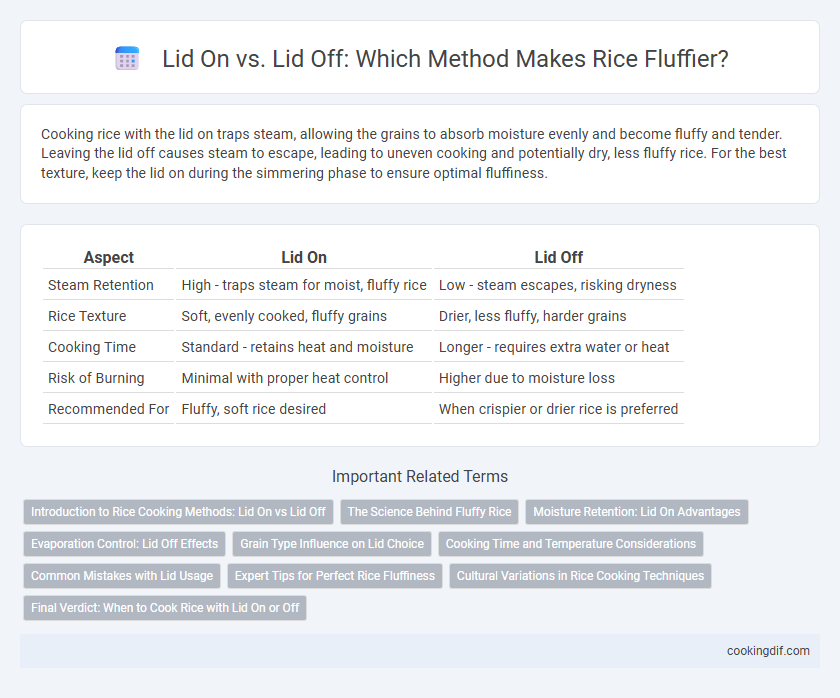Cooking rice with the lid on traps steam, allowing the grains to absorb moisture evenly and become fluffy and tender. Leaving the lid off causes steam to escape, leading to uneven cooking and potentially dry, less fluffy rice. For the best texture, keep the lid on during the simmering phase to ensure optimal fluffiness.
Table of Comparison
| Aspect | Lid On | Lid Off |
|---|---|---|
| Steam Retention | High - traps steam for moist, fluffy rice | Low - steam escapes, risking dryness |
| Rice Texture | Soft, evenly cooked, fluffy grains | Drier, less fluffy, harder grains |
| Cooking Time | Standard - retains heat and moisture | Longer - requires extra water or heat |
| Risk of Burning | Minimal with proper heat control | Higher due to moisture loss |
| Recommended For | Fluffy, soft rice desired | When crispier or drier rice is preferred |
Introduction to Rice Cooking Methods: Lid On vs Lid Off
Cooking rice with the lid on traps steam and heat, ensuring even moisture distribution and resulting in fluffy, tender grains. Keeping the lid off causes moisture to escape, often leading to drier, less cohesive rice with uneven texture. Mastering the lid-on technique is essential for achieving perfect rice consistency in various culinary applications.
The Science Behind Fluffy Rice
Steaming rice with the lid on traps moisture and heat, creating a uniform cooking environment essential for evenly absorbed water molecules and optimal starch gelatinization, which results in fluffy grains. Leaving the lid off causes steam to escape, leading to uneven cooking and drier rice due to evaporation and insufficient starch hydration. Scientific studies on heat retention and moisture control confirm that maintaining a sealed cooking environment is critical for achieving the desired fluffy texture in rice.
Moisture Retention: Lid On Advantages
Keeping the lid on while cooking rice enhances moisture retention, allowing steam to circulate and evenly cook the grains for optimal fluffiness. The trapped steam ensures the rice absorbs sufficient water, preventing dryness and maintaining a soft, tender texture. This method promotes uniform cooking, resulting in fluffy rice with separate, well-hydrated grains.
Evaporation Control: Lid Off Effects
Removing the lid during rice cooking increases evaporation, which affects moisture levels and can lead to drier, less fluffy rice. Evaporation control is crucial to maintaining optimal moisture balance, as excessive steam loss reduces the rice's softness and texture. Keeping the lid on retains steam, ensuring even moisture absorption and consistently fluffy rice grains.
Grain Type Influence on Lid Choice
Long-grain rice, such as Basmati or Jasmine, typically benefits from cooking with the lid on to trap steam, ensuring fluffy and separate grains. Medium and short-grain varieties, including Arborio and sushi rice, often require lid-off cooking to allow excess moisture to evaporate, preventing clumping and achieving desired texture. Understanding the grain type's water absorption and starch content guides the optimal lid choice for perfectly fluffy rice.
Cooking Time and Temperature Considerations
Cooking rice with the lid on traps steam and maintains a consistent temperature, resulting in evenly cooked, fluffy grains. Removing the lid during cooking lowers the temperature and extends cooking time, which can lead to unevenly cooked or sticky rice. Maintaining a gentle simmer at 180-200degF (82-93degC) with the lid on ensures optimal moisture retention and texture.
Common Mistakes with Lid Usage
Leaving the lid off during rice cooking often leads to uneven moisture retention, resulting in dry, hard grains instead of fluffy rice. Common mistakes include lifting the lid frequently, which releases steam and interrupts the cooking process, preventing proper gelatinization of starch. Ensuring the lid remains tightly sealed helps trap steam, creating the consistent heat and moisture necessary for soft, fluffy rice.
Expert Tips for Perfect Rice Fluffiness
Keeping the lid on during the resting phase allows steam to evenly distribute, resulting in fluffier and more tender rice as recommended by culinary experts. Removing the lid too soon lets moisture escape, causing drier, clumped grains that lack the ideal texture. Expert chefs emphasize maintaining a closed environment to trap steam, ensuring each grain separates perfectly for optimal fluffiness.
Cultural Variations in Rice Cooking Techniques
In Japanese cuisine, keeping the lid on during rice steaming helps achieve a tender, fluffy texture by trapping steam evenly. Conversely, some Indian cooking methods prefer lifting the lid periodically to release excess moisture and prevent clumping, which enhances grain separation. These cultural variations reflect distinct preferences for rice texture influenced by regional culinary traditions.
Final Verdict: When to Cook Rice with Lid On or Off
Cooking rice with the lid on traps steam and heat, resulting in evenly cooked, fluffy grains with minimal moisture loss. Lid off cooking allows excess moisture to evaporate, which can prevent sogginess but risks drying out the rice or causing uneven texture. For optimal fluffiness, use a lid during the main cooking phase and remove it briefly at the end to release excess steam before fluffing.
Lid on vs lid off for rice fluffiness Infographic

 cookingdif.com
cookingdif.com